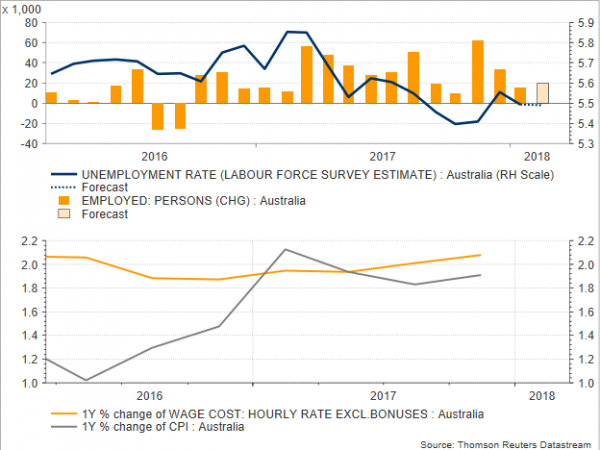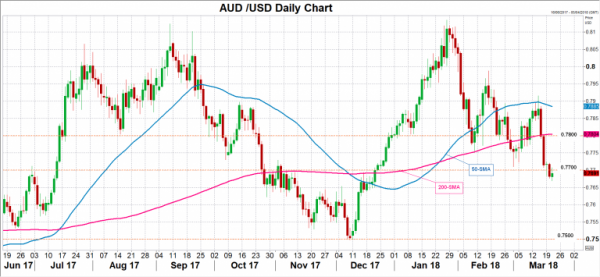Australia will see the release of employment data this week on Thursday at 0030 GMT, with the figures expected to show that the Australian labor market is in a good shape. Analysts believe that the number of jobs created continued to rise in February, posting the longest streak of employment gains since the Australian Bureau of Statistics began its monthly series in 1978. But once again, this is not what aussie traders want to hear most. The path of the unemployment rate and wage growth is what keeps policymakers cautious since both indicators have shown little progress to reach pre-crisis levels even if interest rates stand at record lows. This comes in contrast to the US example where the aforementioned gauges have already approached levels seen in 2009. Because of that, the RBA is in no rush to hike rates despite maintaining a positive note on Australia’s economic performance.
According to forecasts, the number of jobs added to the economy is expected to have increased by 20,000 in February, overcoming January’s rise of 16,000. If the data confirm expectations, the measure would experience nonstop growth for the 17th month. However, if the expansion appears to be led by rising part-time employment and falling full-time positions, as the previous job report indicated, the news would not be as encouraging to the RBA’s ears but rather another problem added to the list. Regarding the unemployment rate which has eased to 5.5% from 5.6% in the preceding month but overall looks to record a sideway trend (5.4%- 5.9%), forecasts are for the measure to remain steady. Yet this level is above the threshold of 5.0% needed to reach to trigger faster wage growth, hinting that the labor market has still some room for improvement. The participation rate or otherwise the proportion of adults in work or searching for work against the general population is also estimated to remain stable at 65.6%.
 The Australian bond yields are currently losing their competitive edge on the back of the Fed’s stimulus reduction measures, with the 10-year Australian bond yields currently standing around 2.70% compared to the US equivalent of 2.85%. Unlike the RBA which drove interest rates to a record low of 1.50% over the past seven years without any hiking, the Fed has delivered five rate hikes since October 2015 and is widely anticipated to announce another one on Wednesday when the FOMC policy meeting concludes. Still, the RBA seems to be ignoring what the Fed is doing as Australia has one more problem to worry about and that is the household debt, with the Swiss-based central bank of central bankers, the Bank for International Settlements, warning that Australia is in a shortlist of countries (Canada, Hong Kong, and mainland China are the others on the list) that are threatened with a mortgage default crisis if their household debt proves unsustainable. The RBA’s meeting minutes published early today also highlighted the risks stemming from the housing sector, reporting that “household debt levels remained high, which contributed to the uncertainty surrounding the outlook for consumption growth”. Besides that, it admitted that despite the improvement in overall conditions and the support of the current accommodative monetary policy which pushed the unemployment rate lower and brought inflation closer to the RBA’s target range of 2-3.0% the progress of these measures is expected to be only gradual.
The Australian bond yields are currently losing their competitive edge on the back of the Fed’s stimulus reduction measures, with the 10-year Australian bond yields currently standing around 2.70% compared to the US equivalent of 2.85%. Unlike the RBA which drove interest rates to a record low of 1.50% over the past seven years without any hiking, the Fed has delivered five rate hikes since October 2015 and is widely anticipated to announce another one on Wednesday when the FOMC policy meeting concludes. Still, the RBA seems to be ignoring what the Fed is doing as Australia has one more problem to worry about and that is the household debt, with the Swiss-based central bank of central bankers, the Bank for International Settlements, warning that Australia is in a shortlist of countries (Canada, Hong Kong, and mainland China are the others on the list) that are threatened with a mortgage default crisis if their household debt proves unsustainable. The RBA’s meeting minutes published early today also highlighted the risks stemming from the housing sector, reporting that “household debt levels remained high, which contributed to the uncertainty surrounding the outlook for consumption growth”. Besides that, it admitted that despite the improvement in overall conditions and the support of the current accommodative monetary policy which pushed the unemployment rate lower and brought inflation closer to the RBA’s target range of 2-3.0% the progress of these measures is expected to be only gradual.
On the trade front, Australia seems to be optimistic that it will get an exemption from Trump’s punitive import tariffs on steel and aluminum after the US president admitted that the US had a trade surplus with its long-term partner. But even if the country does not win an exemption, as Canada and Mexico did – before the tariffs take effect on Friday- Australia is not a big exporter of steel and aluminum. In fact, Australia’s steel and aluminum exports to the US account only about 0.8% and 1.5% respectively of the US import basket. At this point, it is also worth mentioning that the processing of those metals requires Iron ore – mainly on steel production –, a mineral plentiful in Australia (iron ore accounts more than 20.0% of Australia’s exports). Therefore, if US protectionism weighs on iron ore’s demand, the country will definitely feel some economic pain. In addition, the risk could emerge indirectly under the scenario of a potential retaliation from other countries, including China, Australia’s biggest export partner. If a trade war between the US and China begins, harming China’s economic growth, Australia which is sensitive to Chinese economic conditions, could see its terms of trade deteriorating and its job growth narrowing.
Hence, even if Thursday’s jobs report surprises to the upside, the RBA will not change its monetary stance unless it sees job growth translating into faster wage growth which could subsequently help consumers to meet their debt obligations, spend more on goods and services, and therefore push inflation higher. In the forex markets, though, upbeat results could be good news for the aussie. In the wake of better-than-expected readings aussie/dollar could jump above three-month lows reached today, returning to the 0.77 key area. In the best scenario, the pair could crawl above the 200-day simple moving average which currently stands at 0.7800. On the flip side, if the report disappoints, aussie/dollar could extend its downleg towards the 0.7600 handle and even approach December’s low of 0.7500.













